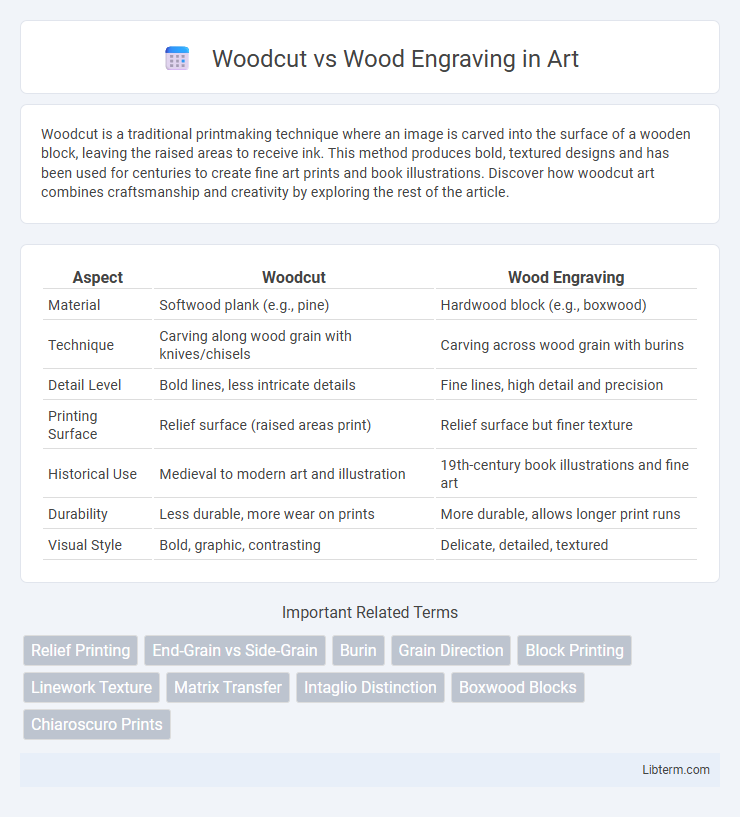Woodcut is a traditional printmaking technique where an image is carved into the surface of a wooden block, leaving the raised areas to receive ink. This method produces bold, textured designs and has been used for centuries to create fine art prints and book illustrations. Discover how woodcut art combines craftsmanship and creativity by exploring the rest of the article.
Table of Comparison
| Aspect | Woodcut | Wood Engraving |
|---|---|---|
| Material | Softwood plank (e.g., pine) | Hardwood block (e.g., boxwood) |
| Technique | Carving along wood grain with knives/chisels | Carving across wood grain with burins |
| Detail Level | Bold lines, less intricate details | Fine lines, high detail and precision |
| Printing Surface | Relief surface (raised areas print) | Relief surface but finer texture |
| Historical Use | Medieval to modern art and illustration | 19th-century book illustrations and fine art |
| Durability | Less durable, more wear on prints | More durable, allows longer print runs |
| Visual Style | Bold, graphic, contrasting | Delicate, detailed, textured |
Understanding Woodcut: An Overview
Woodcut is a relief printing technique where artists carve images into the surface of a wooden block, leaving raised areas to be inked and printed. Typically executed on soft wood with the grain, woodcut allows for bold and expressive lines but tends to produce less detailed images compared to wood engraving. This method has been utilized since ancient times and remains popular for its distinctive texture and artistic style.
What is Wood Engraving?
Wood engraving is a printmaking technique that involves carving fine details into the end grain of hardwood blocks, typically boxwood, allowing for intricate and durable designs. Unlike woodcut, which uses the plank side of softer wood and produces bolder lines, wood engraving enables artists to achieve high precision and subtle tonal variations. This method became especially popular in the 19th century for book and illustration printing due to its capacity for detailed imagery and long-lasting printing surfaces.
Historical Origins of Woodcut and Wood Engraving
Woodcut originated in China during the Tang Dynasty around the 7th century, making it one of the earliest printmaking techniques used to reproduce texts and images. Wood engraving emerged in the late 18th century in Europe, developed by artists like Thomas Bewick, who utilized the end grain of hardwood blocks for finer detail and durability. The historical origins of woodcut emphasize its role in cultural dissemination, while wood engraving reflects advancements in print precision and artistic expression.
Key Differences in Materials Used
Woodcut uses softer woods such as pine or basswood, which allow for easier carving with knives and chisels, producing bold, high-contrast images. Wood engraving employs harder woods like boxwood, providing a dense, fine-grained surface ideal for detailed lines created with burins. The choice of wood directly affects the print's texture and detail, with wood engraving enabling more intricate designs compared to the broader, more graphic quality of woodcuts.
Techniques and Tools: Woodcut vs Wood Engraving
Woodcut uses a plank of softwood and features carving with knives and gouges to create bold, high-contrast images by removing the negative space. Wood engraving employs end-grain hardwood and utilizes fine, precise tools like burins to achieve detailed, intricate lines and textures. The technique differences result in woodcuts producing more graphic, less detailed prints, whereas wood engravings offer refined detail and tonal variation.
Visual Styles and Artistic Outcomes
Woodcut typically produces bold, high-contrast images with rough, expressive lines due to carving along the plank grain, resulting in a more rustic and dramatic visual style. Wood engraving allows for finer details and smoother tonal variations by carving into the end grain, creating intricate, delicate, and nuanced artistic outcomes. The choice between woodcut and wood engraving influences texture, line quality, and depth, affecting the overall visual impact and aesthetic complexity of the artwork.
Popular Artists in Woodcut and Wood Engraving
Albrecht Durer is a seminal figure in woodcut art, renowned for his intricate and highly detailed prints during the Northern Renaissance, while Thomas Bewick revolutionized wood engraving by pioneering the use of end-grain boxwood blocks to achieve fine textures in natural history illustrations. Katsushika Hokusai, famous for "The Great Wave," represents mastery in Japanese woodcuts, combining bold lines with expressive detail. In contrast, Charles Meryon excelled in wood engraving, producing atmospheric views of Paris that showcase the medium's capacity for subtle tonal variation and precision.
Applications in Printmaking and Illustration
Woodcut and wood engraving differ significantly in printmaking and illustration applications, with woodcut using the softer side grain of the plank for bold, high-contrast images ideal for large prints and expressive designs. Wood engraving employs the dense end grain of hardwoods, allowing for finer detail and intricate tonal variations suited for detailed book illustrations and reproductions. Both techniques remain vital in printmaking, with woodcut favored for its traditional, graphic impact and wood engraving prized for precision and subtlety in line work.
Preservation and Collecting Considerations
Woodcut prints, created on softer plank wood, often show more wear due to repeated impressions, making preservation crucial to maintain image clarity. Wood engravings, produced on harder end-grain blocks, generally endure longer and preserve finer detail, appealing to collectors seeking durability and precision. Proper storage in climate-controlled environments reduces deterioration risks for both methods, enhancing the longevity and value of these artworks in collections.
Choosing Between Woodcut and Wood Engraving
Choosing between woodcut and wood engraving depends on the desired detail and texture in printmaking; woodcuts, carved on softwood with tools like gouges, produce bold, coarse lines suitable for expressive designs. Wood engraving, done on end-grain hardwood using burins, offers finer detail and durability, making it ideal for intricate illustrations and high-quality reproductions. Artists should consider the project's complexity, medium, and intended visual effect when selecting between these traditional printmaking techniques.
Woodcut Infographic

 libterm.com
libterm.com